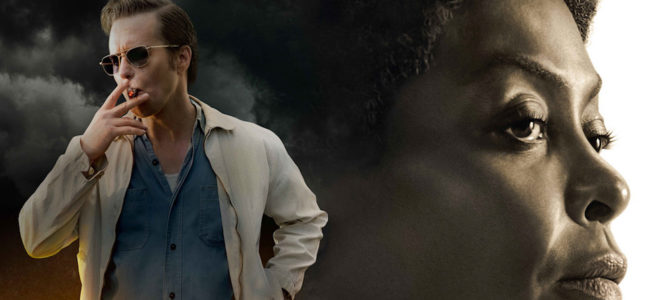
It’s a true story so unlikely, some critics dismiss it sight-unseen as wishful thinking, feel-good corniness, or even a smokescreen for Klansmen’s evil deeds. Yet the hard work of reconciliation did net results for Durham, North Carolina in 1971, ending school segregation and disbanding the local KKK chapter—as depicted in “The Best of Enemies” releasing this weekend.
Nearly two decades after Brown v. Board of Education, the city of Durham still refused to integrate its schools. Yet when a firebombing irreparably damages the school black children attend, community activist and mother Ann Atwater (Taraji P. Henson of “Hidden Figures” and TV’s “Empire”) calls for equal access and funding for all students.
The city council rejects this proposal, egged on by longtime Ku Klux Klan leader C.P. Ellis (Sam Rockwell, Oscar winner for “Three Billboards Outside Ebbing, Missouri”). As unrest grows, city leaders agree to bring in reconciliation leader Bill Riddick. During this era, he pioneered a community meeting concept called a charrette to convene opposing sides to solve problems.
Sparks fly when Riddick gets Atwater and Ellis to co-chair his citywide summit. Speaking in a phone interview from Raleigh, North Carolina, elder statesman Bill Riddick says “The Best of Enemies” makes no apologies for the evils of KKK members, although it does have Ellis’s repentance and redemption at its core.
“We all have beliefs that we have changed,” says Riddick, age 81, who served as a consultant on the film. “I can’t hold a grudge against him because he was a Klansman. We all have biases to set aside, because our culture teaches us stereotypes about people not like us.”
Producer Dominique Telson has spent four years working on the film. “Ann Atwater had a goal,” she says. “To do the work that needed to be done, it meant going up against Ellis. She changed the trajectory of this man’s life—not just once, by getting him away from the KKK, but by saving he and his family’s livelihood.
“Really both their lives were better for it, and I love to tell stories like that.”
Getting History Right
Today, any film centered on race relations and reconciliation in the civil rights era faces skepticism from diverse factions. Consider two recent Academy Award nominees who came under fire.
This year’s Oscar-winning Best Picture “Green Book,” about African American pianist Don Shirley, has been criticized by his living relatives, who say it tells an incomplete and ultimately inaccurate story. Meanwhile, reporting on the undercover cop biopic “BlacKkKlansman” revealed that the Spike Lee film trumped up significant characters and events to make its caricatured plot unlike the real-life events it ostensibly depicted.
From its inception, the team behind “The Best of Enemies” have sought to ground the film in firsthand and historical accounts. The eponymous 1996 book by reporter Osha Gray Davidson chronicles in detail Durham’s entrenched civil rights struggles. Featuring Atwater and Ellis discussing their two-week charrette, the 2002 documentary “An Unlikely Friendship” became another primary source for producers.
“We just told the truth,” says producer Telson. “We didn’t make up these events; it’s all what really happened. Ann was the catalyst [when] her daughter’s school burned down, and the fight became personal. As you see in the film, she went a little reluctantly. Ann didn’t really want to sit across from this guy—they hated each other for years.”
The award-winning producer of “The Hunger Games” and “Seabiscuit,” Robin Bissell makes his directorial debut with this historical drama. He adapted the script from Davidson’s book in addition to personally interviewing key players, including Atwater before her death in 2016. Riddick recalls that Atwater was thrilled when hearing Taraji P. Henson would portray her.
“I was involved with Robin from the beginning, before he wrote a word,” says Riddick, asked about the film’s historical accuracy. “My participation in the movie included reviewing the screenplay, then I went to the set to watch the filming—not all of it, but enough of it to make sure it told the truth. I would not be speaking to you today if it was not the truth.”
Inspiring the Human Spirit Through Film
Hollywood production company Astute Films, launched in 2016 by former Sony executive Fred Bernstein, marks its second release with “The Best of Enemies.” Since he’d admired her work as an independent producer, Bernstein recruited Telson to head creative development.
“He said, ‘I’ve been listening to what you’ve been saying for a while now, and I can’t imagine doing it without you,’” recounts Telson, whose TV movies have aired on Showtime, Hallmark, Lifetime, and BET. “When I joined Astute Films, this was the first film that I wanted to make.”
The producer role involved her in casting (when Paul Giamatti had to bow out, they landed Sam Rockwell), scouting locations (they shot in Atlanta rather than Durham) and working on the film’s $10 million budget—which she calls the hardest part.
“When you’re producing a film, there are battles every day,” says Telson. “For a period drama, this was not easy to fit in what we needed for the amount of money this was made for. As project manager, the producer gets everything together until you get on-set and the actual artists take over: the director, set designer and the beauty of what they do.”
Director Bissell and his team had the benefit of having Riddick himself on set, who recalls the events firsthand. By 1971, the reconciliation specialist had hosted similar successful charrettes in Indiana, Pennsylvania, and other states. Yet upon entering the small town akin to Mayberry, Riddick is told off by Ellis, who uses the demeaning term “boy.”
“I was shocked when I got there,” says Riddick. “But for the charrette to be successful, you have to bring people together who have extreme ideas about the same problem. The co-chairs must have an audience and a following. Then when the charrette happens, they will bring those folks to uphold what it is they believe.”
He courted Ellis and Atwater, whose commanding presence drives the film. Her local nonprofit work reflects her passion for working across ethnic divisions that dominated during that era.
“One of the things I love about Ann Atwater is she wasn’t just an activist for African Americans,” says Telson. “She was an activist for all people in Durham through Operation Breakthrough, whose mission was to help the poor of the community. Ann fought discreetly for the well-being of others, but she was also known as ‘Roughhouse Annie.’ One way or the other, she would get it done!”
Singing From the Same Hymnbook
The ensemble of characters brought together in Durham—notably Atwater, Riddick, Ellis, and his wife—were all professing Christians. It presents seeming contradictions, which “The Best of Enemies” explores. “If you’re going to tell this story, faith has to be a part of it,” says Telson. “It was a key element in the fiber of who Ann Atwater was.”
Riddick recalls his own faith journey. “I grew up in the church and never lost the faith that I had in Jesus Christ,” says the civil rights icon. “I wasn’t so much practicing it, but every time I got in trouble I would pray. When I came home from the first day of the charrette and dealt with my own biases, I really asked the Lord to guide me through the process.”
Atwater’s faith shows up throughout, even over lunch. The charrette hosted by Riddick used various tactics to challenge participants daily. Everyone involved had to dine and dialogue with a person of another ethnicity, including the stubbornly opposed co-chairs seated at a head table for two.
Producer Telson praises how the film’s lead brought her faith forward in big and small ways. “This is the beauty of Taraji P. Henson, who studied who this woman was,” says Telson. “Sitting across from C.P. at the table, she puts her hands up in prayer—reflecting her black church roots. That wasn’t written in the script! It’s Taraji channeling Ann Atwater.”
Late on a Friday, as Riddick wrapped up half of a planned two-week process, little progress seemed evident. A black clergyman had invited his church choir to close the time with a song. While some white participants left, Ellis stayed. Riddick recalls seeing Atwater lean over to Ellis as the energetic choir ramped up.
“He didn’t know how to clap in rhythm, how black people clap in rhythm,” says Riddick. “She was trying to teach him how to do that. It had an effect on him and was one of the parts of him starting to change.”
A father of four including a son with developmental struggles, Ellis attended church weekly with his family—where he also recruited for the local KKK Youth Corps. As the son of a textile mill worker, his economic situation differs little from Atwater, who was born to a family of sharecroppers. Gradually, he comes to realize how his actions contradict the biblical ethic of human dignity.
Telson recalls a favorite scene that boils down the core conflict. After a 12-hour day of emotional dialogue, the two co-chairs head to their cars. “Yeah, I go to church and have a Bible,” Ellis says offhandedly. “Ann replies, ‘Oh yeah—Do you read it?’” recounts the producer. “When you look at his face there, this sheepish grin that he has, it is portrayed exactly right.”
“She is challenging how he lives his faith,” says Telson. “You’re calling yourself a Christian, but isn’t being a Christian about loving everybody? That’s not really what you’re doing here, buddy.”
Inspiration to Persevere for Justice
A father of three and grandfather of seven with his wife Delores, Riddick is optimistic for America to continue to better reflect racial equality and opportunity for all.
“I have lived long enough to see a lot of things change,” says Riddick. “I was born in the 1930s and have seen society improve tremendously. Obviously, over the last couple years, we have regressed a little bit especially on matters of race and class. But we will work through this.”
Recent years have brought several flashpoints affecting race relations, from policing incidents that ended in the loss of life, to the infamous August 2017 rally in Charlottesville, Va. that resulted in three deaths. The nation has also seen recent progress, such as criminal justice reform beginning to impact how mass incarceration disproportionately affects minorities.
“Alarm bells are ringing loud, but one of the things America is famous for doing is adjusting,” adds Riddick. “I think we will adjust and get back on the road to where everybody is valued in this country.”
Diverse voices have offered praise for “The Best of Enemies,” from TheGrio news portal serving African American readers to conservative commentator Hugh Hewitt. Filmmakers contend it speaks directly to the current moment.
“We began this film in 2015, and we thought we were making it that year,” says Telson. “But then ‘Empire’ just took off, and Taraji was really too busy to do anything else. She put the script in a drawer. We were kind of at a loss to figure out what to do.”
The producer recalls a conversation she had in late 2016 with Henson. The star said, “When the election happened, I remembered this Ann Atwater and pulled out my script. I thought: We’ve got to do this now.”
As it opens this weekend on more than 1,700 screens nationwide, audiences will laugh, cry, cringe, and empathize with these strange bedfellows who work together for the common good. Producers foresee greater personal and societal shifts could result.
“I hope that people will be inspired by this film, to get out from behind your Twitter account, look somebody in the eye and have a conversation,” concludes Telson. “When C.P. and Ann got in front of each other, they stopped hating each other and saw themselves as people.”
This article has been corrected in regards to how Atwater’s children’s school was damaged.









